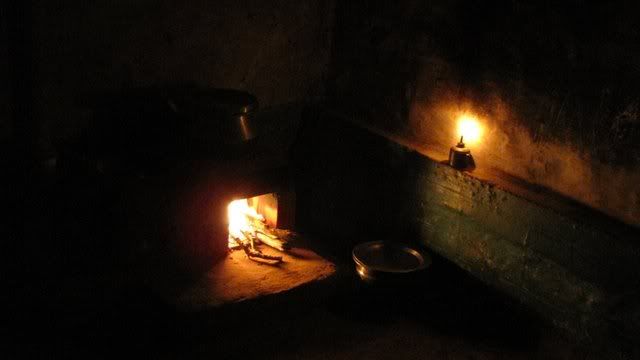Madheswara Home Stay, Chik Yelchetti, Bandipur
I’ve joined an organization called
which my friend Ramesh (I met him on the NTP) takes care of; and since they are supporting (for the past three and a half years now) a homestay in a village called Chik Yelchetti, abutting the Bandipur forest, I said I’d go and do a nature trail there, giving the local guide an idea of what visitors would like to see.
From Bangalore, we left just past 9am, took the NICE road, and took a break for an early lunch at Mysore. We reached Bandipur by about 2.30, and Chik Yelchetti is a few kilometres in the interior from the main Mysore-Ooty Road, past Mangala village.
Here’s the home-stay…doesn’t it look beautiful?
In the centre is the temple, which has pujas twice a week; on the left is the cooking area. We go into the passage between the cooking area and the blue building, and get to the area where guests are put up.
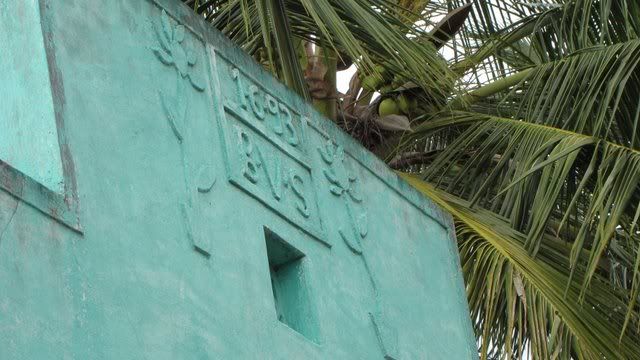 Here are the sleeping/dining area of the home-stay:
Here are the sleeping/dining area of the home-stay:
 At present, they have three large cots with bedding, in the sleeping area. The rush mats keep the beds cool:
At present, they have three large cots with bedding, in the sleeping area. The rush mats keep the beds cool:
 The idea of the homestay is also to keep the numbers rather low; Junglescapes wants to ensure that Subbanna gets enough guests for him to clear Rs.3000 or so a month; too many guests would spoil the scene. Also, Junglescapes makes sure that the guests are truly eco-conscious visitors, not camera-toting tourists, arriving in their SUV's, avid for "rural life".
This is the doorway through which one steps into the guest area:
The idea of the homestay is also to keep the numbers rather low; Junglescapes wants to ensure that Subbanna gets enough guests for him to clear Rs.3000 or so a month; too many guests would spoil the scene. Also, Junglescapes makes sure that the guests are truly eco-conscious visitors, not camera-toting tourists, arriving in their SUV's, avid for "rural life".
This is the doorway through which one steps into the guest area:
 This is half enclosed with tiles, and half open to the sky, with a huge Bougainvillea plant partially covering and shading the open area, an an old cartwheel is stored there, as well:
This is half enclosed with tiles, and half open to the sky, with a huge Bougainvillea plant partially covering and shading the open area, an an old cartwheel is stored there, as well:
 Just outside the home-stay is this absolutely gigantic Peepal tree, which our hosts tell us must be about a 150 years old...I can easily believe it!
Just outside the home-stay is this absolutely gigantic Peepal tree, which our hosts tell us must be about a 150 years old...I can easily believe it!
 To me, this tree was as much a temple of Nature as the shrine in front of it.
Here is Subbana, the priest of the temple, and our host, welcoming us as we walk in:
To me, this tree was as much a temple of Nature as the shrine in front of it.
Here is Subbana, the priest of the temple, and our host, welcoming us as we walk in:
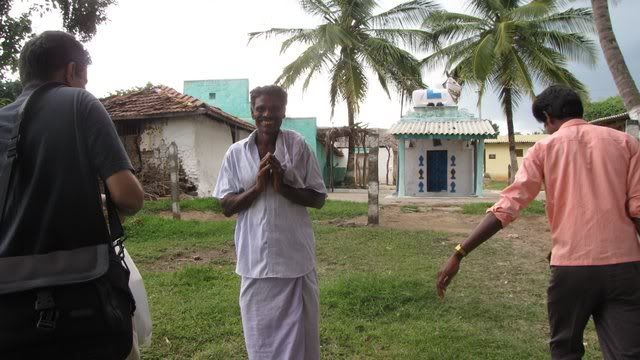 In front of the peepal tree, Subbana has put up some granite slabs to serve as a communal sitting area. Here are Ramesh, Subbanna, and his son Ravi, who is the guide to the areas around:
In front of the peepal tree, Subbana has put up some granite slabs to serve as a communal sitting area. Here are Ramesh, Subbanna, and his son Ravi, who is the guide to the areas around:
 Here is another view of the sitting area.
Here is another view of the sitting area.
 Here, the families seem matriarchal. Ravi stays with his in-laws in Nanjangud. Here's Subbana's daughter's son, Darshan:
Here, the families seem matriarchal. Ravi stays with his in-laws in Nanjangud. Here's Subbana's daughter's son, Darshan:
 As soon as we put down our bags, Subbanna offered us peanuts (a major crop in the area), jaggery, and jaggery-sweetened tea, piping hot:
As soon as we put down our bags, Subbanna offered us peanuts (a major crop in the area), jaggery, and jaggery-sweetened tea, piping hot:
 In the passage to our guest area, a plough has been stored.
In the passage to our guest area, a plough has been stored.
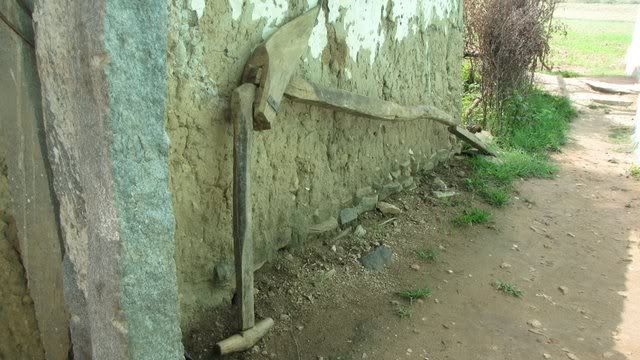 At the entrance to the passage is this lovely bas-relief of the monkey God, AnjanEyA, which the hostess said was found in the forest by Subbanna's father, and brought home:
At the entrance to the passage is this lovely bas-relief of the monkey God, AnjanEyA, which the hostess said was found in the forest by Subbanna's father, and brought home:
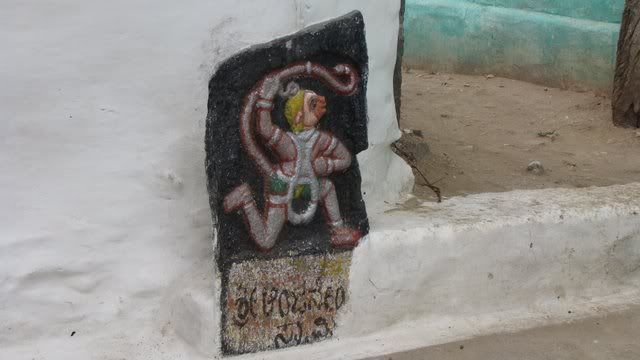 There is a lovely little stream near the sitting area, and on its banks is this little bAvi, or well, worshipped as a source of water:
There is a lovely little stream near the sitting area, and on its banks is this little bAvi, or well, worshipped as a source of water:
 Here's the bridge on the path from the homestay to the rest of Chik Yelchetti village:
Here's the bridge on the path from the homestay to the rest of Chik Yelchetti village:
 Ramesh gave Ravi a copy of Purnachandra Tejaswi's Kannada bird-book, and here he is, on the banks of the little pond abutting the stream, dipping into it (the book, not the stream!)
Ramesh gave Ravi a copy of Purnachandra Tejaswi's Kannada bird-book, and here he is, on the banks of the little pond abutting the stream, dipping into it (the book, not the stream!)
 I sat with him later in the evening, and we ticked off all the birds that he had seen in the area.
We visited some of the houses in Chik Yelchetti in the evening, and everywhere, the harvest of peanuts were stored:
I sat with him later in the evening, and we ticked off all the birds that he had seen in the area.
We visited some of the houses in Chik Yelchetti in the evening, and everywhere, the harvest of peanuts were stored:
 Here's one housewife, cleaning her home:
Here's one housewife, cleaning her home:
 Junglescapes is working with a Philips (Delhi) social initiative called "Philanthropy Through Design". They have designed "eco-chulhas" (chulha=stove) that use much less fuel than the traditional stoves, produce far less smoke, and also can burn lantana twigs:
Junglescapes is working with a Philips (Delhi) social initiative called "Philanthropy Through Design". They have designed "eco-chulhas" (chulha=stove) that use much less fuel than the traditional stoves, produce far less smoke, and also can burn lantana twigs:
 This has multiple benefits. The smokeless chulha means much better health for the residents of the house; the economy of firewood means that they have to make much fewer trips into the forest, eliminating both the plunder of trees, and the safety hazard to the villagers in terms of confrontation with wild animals.
We then visited the home of Kala (pronounced kAlA not kalA) Setty, who makes a medicine (useful, he says, for treating leprosy and other ailments...people come for it from as far away as Hyderabad, he says). It was dark by now, so I had to use the flash....here are the roots that, he says, he collects from the fields nearby:
This has multiple benefits. The smokeless chulha means much better health for the residents of the house; the economy of firewood means that they have to make much fewer trips into the forest, eliminating both the plunder of trees, and the safety hazard to the villagers in terms of confrontation with wild animals.
We then visited the home of Kala (pronounced kAlA not kalA) Setty, who makes a medicine (useful, he says, for treating leprosy and other ailments...people come for it from as far away as Hyderabad, he says). It was dark by now, so I had to use the flash....here are the roots that, he says, he collects from the fields nearby:
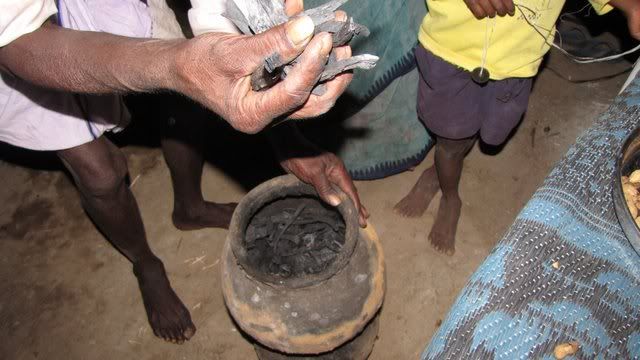 He packs the roots into one pot with a hole in it, and buries it with another pot under it. He then packs firewood around the top pot, and the "oil" slowly drips into the pot below.
He packs the roots into one pot with a hole in it, and buries it with another pot under it. He then packs firewood around the top pot, and the "oil" slowly drips into the pot below.
 He does not claim to know any medicine other than this, and says he's only had three people learning about this medicine from him so far.
I saw, after a long time, the traditional way of storing curds and milk away from rodents:
He does not claim to know any medicine other than this, and says he's only had three people learning about this medicine from him so far.
I saw, after a long time, the traditional way of storing curds and milk away from rodents:
 The next day, we visited the village of Lokkere:
The next day, we visited the village of Lokkere:
 I found this unfinished sign painted nearby!
I found this unfinished sign painted nearby!
 As we sat and talked to Nagendra, who is the resource person for the Eco-Chulhas and the afforestation here, I snapped the colours of the Bougainvillea, peeping through the gap between wall and thatch:
As we sat and talked to Nagendra, who is the resource person for the Eco-Chulhas and the afforestation here, I snapped the colours of the Bougainvillea, peeping through the gap between wall and thatch:
 Lokkere has a lot of tomatoes being grown:
Lokkere has a lot of tomatoes being grown:
 Nagendra's cowshed:
Nagendra's cowshed:
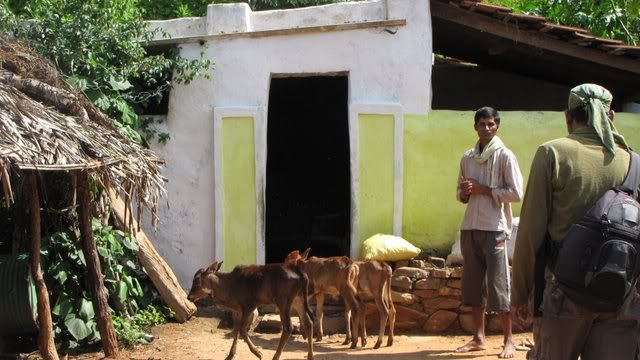 They also had this beautiful calf, looking at the roosters:
They also had this beautiful calf, looking at the roosters:
 On the front portico of a house, this traditional "Ludo"-like game was chiselled:
On the front portico of a house, this traditional "Ludo"-like game was chiselled:
 As Ramesh went to inspect the growth in the afforested area, I looked around at a shrine under a huge Ficus tree, and saw these two lingA stones:
As Ramesh went to inspect the growth in the afforested area, I looked around at a shrine under a huge Ficus tree, and saw these two lingA stones:
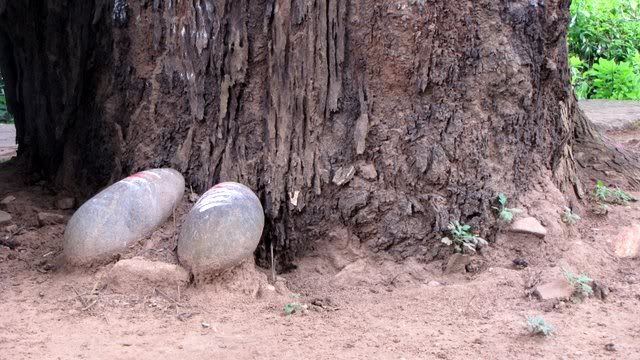 Here's one small temple:
Here's one small temple:
 In front of it was an old Hero Stone, with ancient Kannada writing,faintly visible on it:
In front of it was an old Hero Stone, with ancient Kannada writing,faintly visible on it:
 The poverty of these villages is palpable, and yet the villagers are cheerful and very hospitable, offering us whatever food and drink they have.
The poverty of these villages is palpable, and yet the villagers are cheerful and very hospitable, offering us whatever food and drink they have.
I’ll close with this image of the home fires buring in one of the village homes….I want more people to visit Chik Yelchetti, to enable the village to see a little more prosperity!


